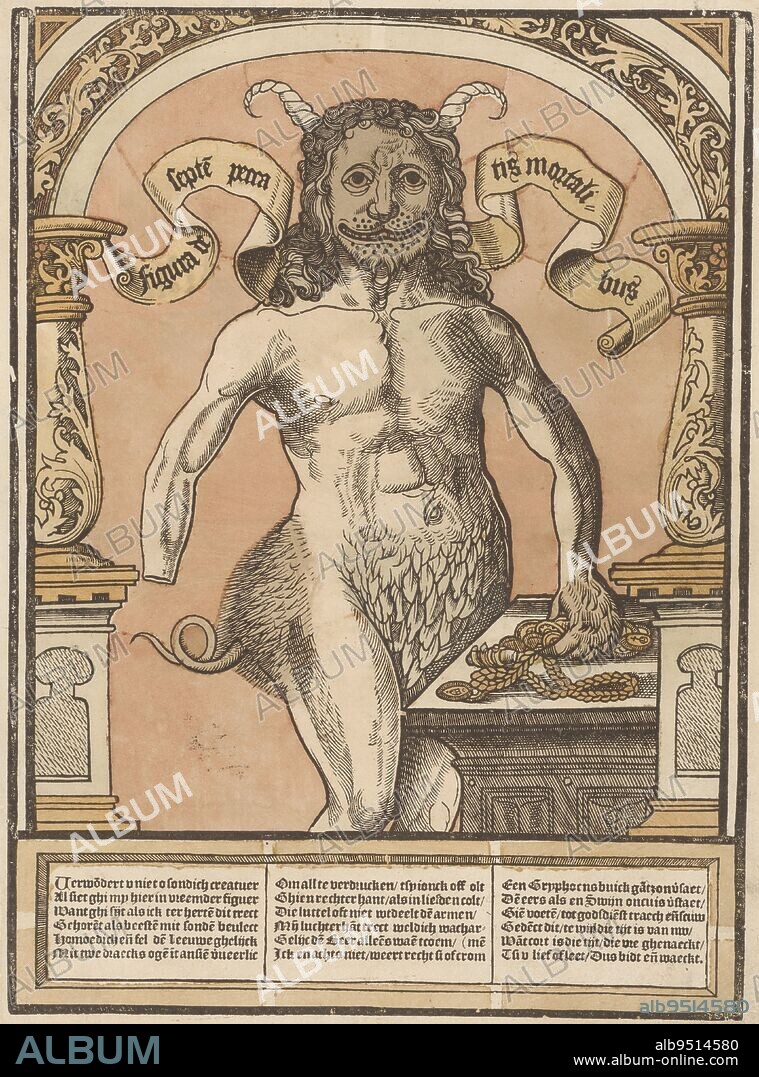alb9514580
The Seven Deadly Sins, anonymous, 1540 - 1567, Devil figure composed of body parts of various animals, personifying the seven deadly sins. Standing in a niche. The lion's head symbolizes Pride, the dragon's eyes represent Wrath, the absence of the right hand represents Avarice, and the hindquarters of a boar represent Unchastfulness. On either side of the head the text: Figura de septe peccatis mortalibus. The way the monster is represented goes back in part to a poem by Hans Sachs: 'Der Eygennutz, das Grewlich Thier', 1535. Below text in Dutch in three columns., print maker: anonymous, publisher: Peter Warnerssen, (mentioned on object), print maker: Low Countries, publisher: Kampen, 1540 - 1567, paper, h 395 mm × w 278 mm.

|
Zu einem anderen Lightbox hinzufügen |
|
Zu einem anderen Lightbox hinzufügen |



Haben Sie bereits ein Konto? Anmelden
Sie haben kein Konto? Registrieren
Dieses Bild kaufen.
Nutzung auswählen:

Untertitel:
Siehe automatische Übersetzung
The Seven Deadly Sins, anonymous, 1540 - 1567, Devil figure composed of body parts of various animals, personifying the seven deadly sins. Standing in a niche. The lion's head symbolizes Pride, the dragon's eyes represent Wrath, the absence of the right hand represents Avarice, and the hindquarters of a boar represent Unchastfulness. On either side of the head the text: Figura de septe peccatis mortalibus. The way the monster is represented goes back in part to a poem by Hans Sachs: 'Der Eygennutz, das Grewlich Thier', 1535. Below text in Dutch in three columns., print maker: anonymous, publisher: Peter Warnerssen, (mentioned on object), print maker: Low Countries, publisher: Kampen, 1540 - 1567, paper, h 395 mm × w 278 mm
Bildnachweis:
Album / quintlox
Freigaben (Releases):
Model: Nein - Eigentum: Nein
Rechtefragen?
Rechtefragen?
Bildgröße:
4154 x 5605 px | 66.6 MB
Druckgröße:
35.2 x 47.5 cm | 13.8 x 18.7 in (300 dpi)
Schlüsselwörter:
ABWESENHEIT • ANONYME • HOLLAENDISCH • KLEIDUNG, HOLLAENDISCH • KOERPERTEILE • KOPF (ANATOMIE) • KOPF • OBJEKT • PAPIER • PERSONIFIKATION • SIEBEN TODSUENDEN • STEHEND • TEXT • TODSUENDE • TODSÜNDE • UNGEHEUER • VERSCHOLLEN SEIN
 Pinterest
Pinterest Twitter
Twitter Facebook
Facebook Link kopieren
Link kopieren Email
Email
